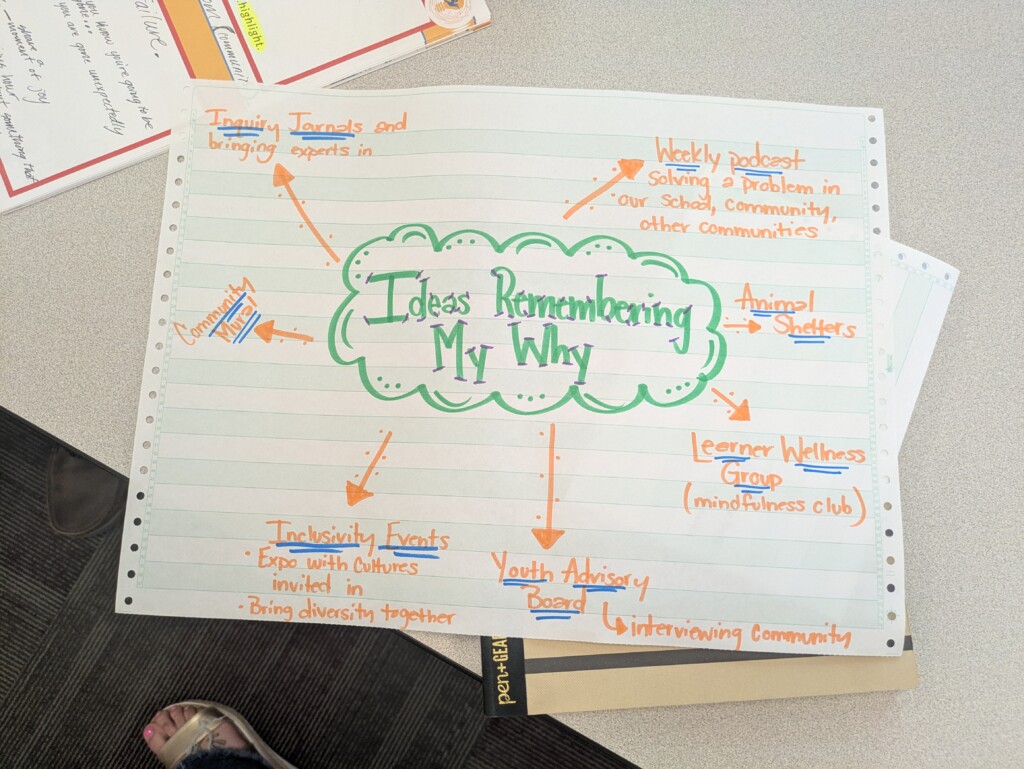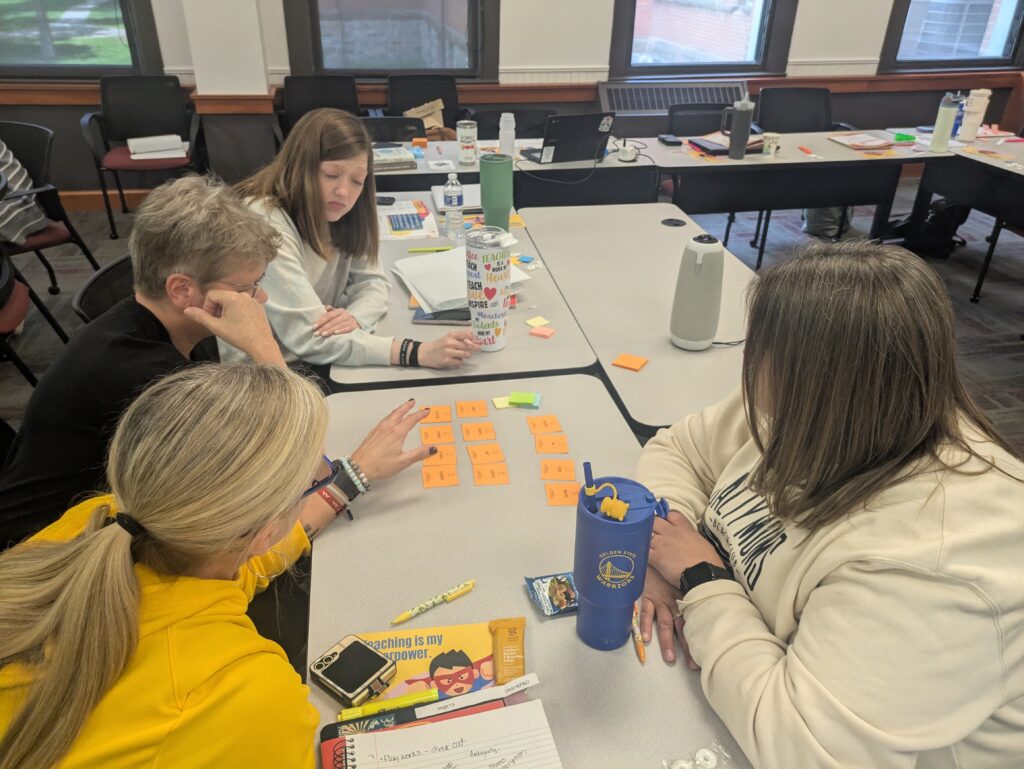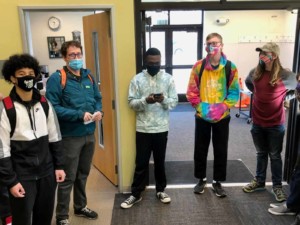Problems Become Possibilities: The Power of Educator Incubators
Key Points
-
Educator incubator models provide a trust-based, actionable professional development framework that empowers teachers to co-solve real-world problems with students and their communities.
-
Shifting from passive teaching practices to active problem-solving leadership significantly improves teacher satisfaction, reduces burnout, and strengthens community impact.

By: Darcy Bakkegard
At a workshop this summer, Kalyn, a 24-year teaching veteran, turned to our group and said, “I’m losing my spark. I’m losing my fight in a community of no’s.”
While your wording may be different, how many of you have echoed Kalyn’s sentiment? How many Kalyn’s do you know and work with? Consider the huge loss in productivity and ingenuity when teachers and students are stuck in a “community of no’s.”
Imagine instead, a system that says YES; a system in which educators identify genuine problems and then play with possible solutions. They analyze every angle, breaking down the problem to its root causes, then assess where action is both possible and will have the greatest impact.
Imagine that this type of learning is both common AND funded: educators can access small “spark funds” to implement their solutions and test their ideas. While initial projects may be small in scope, as learners test their Design Thinking/Human Centered Design skills and expand their competency, confidence grows. Having experienced the power of trust, they’re more willing to take risks, excited to tackle harder concepts and bigger challenges. The scope and impact of the projects and solutions grow, fueling greater change and impacting communities in vital ways. This work is the soul of R&D, and it has never been a more important time to find ways to sustain and nurture education R&D across the country. As national funding for education R&D evaporates, we can shift to more nimble, localized models of R&D, fueled by and for teachers.
What is being described is not only a learner-centered school but a robust and rigorous incubator model for teacher professional learning. While incubators are a common occurrence in the business and startup world, their agile approach to iteration has yet to gain traction in education. My experience is that when teachers experience the incubator model (and other trust-based professional learning), they flourish.

Incubators as a PD Model
An incubator’s main goal is simple: Incubate and grow ideas. Inherent in the model is an emphasis on problem-solving, community collaboration, and creating opportunities for student and teacher agency. The incubator model thrives by creating a space for teachers to work on normal, everyday pain points they normally never get to address, as well as the bigger pain points. Everything from classroom engagement to absenteeism, incorporating a new reading curriculum to increasing movement, activating community partnerships to launching personalized learning.
Most importantly, incubators focus on shifting teachers from passive participants in a system to active leaders addressing the problems that they face. The big and bad, the mundane and mandated, the tactical and tiny. And when teachers have the time and support to focus on the issues that make teaching and learning harder for them and their students, it increases joy, decreases stress, and accelerates impactful results for all.
I lead the Teacher Empowerment Incubator, a pilot program in North Dakota designed to ignite teacher-led innovation, fuel community collaboration, and increase student engagement. Funded by the Burgum Foundation, the Teacher Empowerment Incubator (TEI) supports 12 rural North Dakota teachers, helping them test solutions to classroom frustrations and foster meaningful community collaborations. This is hands-on, localized research and design. Each teacher identifies a genuine community need, and then, working with their students, designs and implements a solution. In addition to training and ongoing coaching for one year, each participant receives three continuing education (renewal) credits and up to $1500 to fund their community initiative.
The pilot cohort includes teachers of every grade and subject, with experience ranging from 3 to 24 years. The common denominator: All were feeling disillusioned. All were questioning how much longer they could stay in the classroom.
After two days together for in-person training, 100% of the cohort “strongly agreed” or “agreed” with the following statements:
- After completing this training, I feel more hopeful about the impact I can have in my classroom and community.
- After completing this training, I feel more hopeful about teaching (in general).
These shifts in confidence and energy are game-changing for teachers and the students/communities they serve. The TEI pilot is only five months into year one, and already, community gardens are taking root; kindergarteners are exploring their communities and being empowered as helpers; students are producing local biographies and building community pride via beautification projects. Students are presenting at school board and city council meetings, talking to mayors, and mobilizing fundraising efforts.
Remember Kalyn? “I’m losing my spark. I’m losing my fight in a community of no’s.” After our initial TEI training, Kalyn finished that thought by saying, “Now, after today, I’m like- yeah! Let’s kickass!”
Diamond, a young kindergarten teacher, emailed to say, “Things have started to roll and the ideas are flowing! Once we started the conversation of how to give back to our community- we just keep thinking of more things that we can do! I’m feeling so excited!!”
And 20-year teaching veteran Dawn shared, “I can’t tell you how amazed I am at how this has been going. The kids have talked to the administrators, they are planning a presentation in front of the school board, they are researching funding sources…Kids I did not expect to lead are speaking to administrators and bringing our ideas to life! I feel rejuvenated…and remember why I teach. Wow! Wow! WOW!”
Why do incubators work?
The individual shifts in teacher satisfaction (noted above) are reason enough to utilize the incubator model for staff professional learning. But the wins are much richer and broader than the impact on individual educators.
Increase efficiency for districts and schools.
- Increase Collective Teacher Efficacy. Education researcher John Hattie reports in his meta-analysis of education research that a staff’s belief that they CAN make a difference is the number one indicator that they WILL make a difference. Empowering staff to design and own solutions to challenges builds a team of problem-solvers focused on doing what’s best for students.
- Decrease cost and save time. In the hands of students and teachers—in partnership with our community—innovation is done at a fraction of the cost. By investing directly in teachers and creating conditions that enable them to work together with their students to solve challenges, results are achievable and data are accessible in months, not years.
- Reclaim the narrative around schools/schooling. Being solutions-driven while encouraging student/teacher/community collaborations highlights the importance of schools in our communities.
Accelerate authentic learning experiences for students.
- Increase student agency. Students play a key role in problem-solving and building a community coalition for implementation. Supercharge existing efforts like Portrait of a Graduate, rooting them in authentic, hands-on experiences.
- Build a community of problem-solvers. The focus on human-centered design/action research helps teachers hone their problem-solving skills while amplifying their ability to model those same skills with and for students.
Reignite the passion and purpose of educators.
- Decrease burnout: Research on stress shows that a sense of control is vital in reducing stress. Engaging educators (and students) as strategic problem-solving partners helps them own pieces of the solution. Even if the solution isn’t perfect, the process of problem-solving alone helps reduce stress and burnout.
- Increase teacher retention. When aligned with their purpose, educators are reinvigorated. For many, working with their students to solve problems and thereby creating a more learner-centered, personalized classroom, lights up all the purpose requirements.
- Highlight the importance and viability of a career in education. When teachers are seen as changemakers, when they act as leaders who tackle big problems and work with students and the community to find solutions, we help shift the perception of teaching and education. We can make “teacher” the buzz-worthy, status career it should be.
How to Launch an Educator Incubator
Are you ready to give it a try? Here’s how we got started.
- We assembled a group of interested individuals. All rural educators were invited to apply. 12 were selected to create a diverse group. 12 proved to be a great group size: Large enough for diverse ideas, small enough for everyone to quickly be comfortable with each other. These two factors were vital to the fast-paced, at times vulnerable workshop format. Start with those excited about the idea. Once they see what’s happening, others will WANT to join in.
- We provided concrete, meaningful enticements. Stipends for hotel and travel, continuing education credits, and spark grants to support the implementation of their idea. We partnered with Valley City State University’s Education Department, which provided a site for the workshop and will issue continuing education credit. This should not be extra or separate. This model can replace existing PD/inservice/staff meetings.
- We created space for innovation and collaboration. We met in person for two days during the summer. No one solution was offered. Instead, teachers gathered and explored how and why they might set up authentic problem-based learning with and for their students. We wrestled with ambiguity and mentally prepared to not have all the answers before school started in the fall. The emphasis, instead, was on identifying possible opportunities, initiating community contacts, and building confidence in teaching while not having all the answers ahead of time. This aspect was and remains the hardest part for our cohort. These dedicated teachers want to give students the BEST. Not knowing exactly what will happen or how it will play out is an exercise in vulnerability and trust.
- We emphasized community partnerships and collaboration. When teachers thought this was all on them, it was overwhelming. When we brainstormed possible community connections -in the schools/districts, towns/counties, and our state- excitement grew and everyone started to feel this was not only doable, but necessary. Community support focused on creating win-win-win scenarios for all involved by focusing on actual community problems. To save time during the school year, teachers started connecting with area agencies and groups to gather a list of interested partners. While we did not know exactly what projects would emerge, building connections with local Chambers, service groups, and business leaders is now expediting collaboration and implementation.
A few facilitation notes to keep in mind
Teachers may be reticent to take the leap and try something, even when invited. Remember: Most teachers have NOT been encouraged to design their own solutions. Yes, they write lesson plans, but a lot of teachers have heard ‘no’ so many times -both externally and internally- that many have stopped dreaming/exploring. It may take time for teachers to trust that they have autonomy and agency to act.
Focus on real issues. Each community has unique challenges, providing authentic opportunities for problem-solving. While many problems in education are universal and allow for whole-group brainstorming, the solutions must be tailored to each community. Trust that curriculum will happen. We started with the problems, and for EVERY ONE, curriculum ideas and connections emerged. If you start with the curriculum first, the projects/solutions will not be nearly as authentic, which will limit agency and buy-in.
Encourage teachers to work with their students to design and implement their solution. Once the group was back in their classrooms, they found the excitement of their students further fueled action as students stepped up and took on responsibilities. Again, when the problems are real, purpose and passion are activated. While some teachers identified a problem before school started, many are working with their students to identify problems that resonate with the class. This process is a fantastic way to address building and district challenges. Empower the people closest to the problem to identify and test solutions. That said, be honest about where you’re willing to hand over control to a teacher/student group. They have to have agency to try THEIR plan, not be limited by district mandates.
Provide ongoing encouragement and support for teachers. For our ND Teacher Empower Incubator, this happens via monthly one-on-one coaching sessions and through bi-monthly group connections. Utilize team and/or staff meetings to engage in collaborative problem-solving, share updates, and celebrate the implementation of solutions (no matter the outcome).
You’ve Got This… Time To Get Started
The scariest aspect of the incubator process: The unknown. When teachers -and then students- have agency, the EXACT process is unknown. The exact partners are unknown. The exact outcome is unknown.
Here’s what is known: Teachers became teachers because they want to help kids. We have ample evidence that what we’re currently doing is NOT working. Let’s lean into the unknown and the uncomfortable and uncover something new using responsive and localized R&D systems.
Turn problems into possibilities and tap into the power of our greatest education resource: Teachers. When we create trust-based, vibrant, cooperative learning opportunities for teachers via educator incubators and accelerators, the wins stack up on all sides.
Darcy Bakkegard is a change consultant, co-founder of The Educators’ Lab, and co-author of The Startup Teacher Playbook. After more than a decade in the classroom teaching English and theatre, Darcy now creates the type of PD she always wanted, driving change in education and empowering teachers as changemakers. Through her work, teachers reconnect with their purpose, rekindle their spark for teaching, and reignite the JOY of teaching and learning.





0 Comments
Leave a Comment
Your email address will not be published. All fields are required.